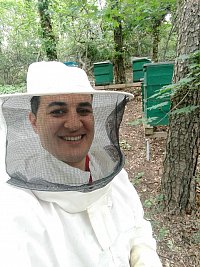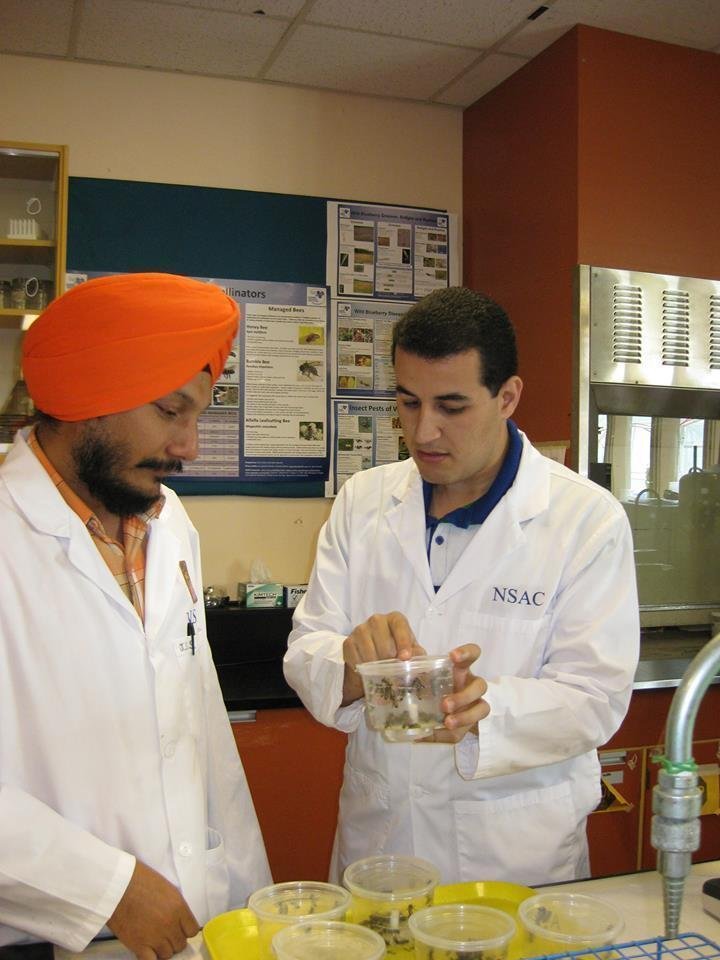Dr. Yahya Al Naggar

|
Contact: Dr. Yahya Al Naggar Room 6. 11, Institute of Biology, High Road 8 06120 Halle (Saale), Germany. E- mail: yehia.elnagar@science.tanta.edu.eg yahya.alnaggar@zoology.university hall.de Phone: +49 (0) 345 55 26503
|
|---|
Short Biography
I am Yahya Al Naggar, associate professor, Faculty of Science, Tanta University, Egypt. Currently affiliated as postdoc research scientist at the Institute of Biology, General Zoology, Martin-Luther-University Halle-Wittenberg, Germany. With education and training in ecology, pesticide toxicology, nanotoxicology and ecological risk assessment, from Egypt and three different countries (Canada, USA, and Germany).
Over the last 10 years, my research interests lie in unravelling the causes of honeybee colony collapse disorder (CCD) which is a current ‘hot’ topic. I'm conducting lab and field experiments to address the effects of different environmental and ecological stressors (pesticides, parasites, and pathogens) on honey bee health, either individually or in combination. I'm also interested in the impact of hazardous heavy metals like cadmium and lead, as well as their nanoparticles and newly emerging pollutants (microplastics) on honey bees health and other insect species. Overall, I have authored and co-authored 47 publications in high ranked peer-reviewed journals with 913 citations and an h-index of 17 (source: Google Scholar).
1. ACADEMIC POSITIONS
2021- current: Associate Prof. Fac. Sci. Tanta Uni. Egypt. (Authorized absence leave)
2019-2022: Humboldt postdoc fellow; Institute of Biology, MLU Halle (Saale), Germany.
2018: Postdoc fellow, Entomology Department, University of California at Riverside, USA.
2015-2020: Assistant prof. zoology department, Faculty of Science, Tanta Uni. Egypt.
2009-2013: Assistant lecturer zoology department, Faculty of Science, Tanta Uni. Egypt.
2. EDUCATION AND TRAINING
2003-2007: B.Sc. Biological Sciences, Tanta University, Egypt University.
2009-2011: M.Sc. Insect Ecology, Tanta University, Egypt University
.2012-2015: Ph.D. Insect Ecology, Tanta University, Egypt.
2013-2015: Visiting Ph.D. scholar, toxicology center, Saskatchewan University, Canada.
2014: Visiting Ph.D. scholar, agricultural campus, Dalhousie university, Canada.
Some selected Publications:
1. El-Din, H. S., Helmy, W. S., Al Naggar, Y., & Ahmed, F. S. (2022). Chronic exposure to a field-realistic concentration of Closer® SC (24% sulfoxaflor) insecticide impacted the growth and foraging activity of honey bee colonies. Apidologie, 53(2), 1-12.
2. El-Seedi, H. R., Ahmed, H. R., El-Wahed, A. A. A., Saeed, A., Algethami, A. F., Attia, N. F., ... & Wang, K. (2022). Bee Stressors from an Immunological Perspective and Strategies to Improve Bee Health. Veterinary Sciences, 9(5), 199.
3. Hamed, M., Soliman, H. A., Eid, Z., Al Naggar, Y., & Sayed, A. E. D. H. (2022). Dietary Feeding Lycopene, Citric Acid, and Chlorella Alleviated the Neurotoxicity of Polyethylene Microplastics in African Catfish (Clarias gariepinus). Frontiers in Environmental Science, 535.
4. Algethami, J.S.; El-Wahed, A.A.A.; Elashal, M.H.; Ahmed, H.R.; Elshafiey, E.H.; Omar, E.M.; Naggar, Y.A.; Algethami, A.F.; Shou, Q.; Alsharif, S.M.; Xu, B.; Shehata, A.A.; Guo, Z.; Khalifa, S.A.M.; Wang, K.; El-Seedi, H.R. (2022) Bee Pollen: Clinical Trials and Patent Applications. Nutrients, 14, 2858. https://doi.org/10.3390/nu14142858
5. Yan, S., Wang, K., Al Naggar, Y., Vander Heyden, Y., Zhao, L., Wu, L., & Xue, X. (2022). Natural plant toxins in honey: An ignored threat to human health. Journal of Hazardous Materials, 127682.
6. Khalifa, S. A., Elshafiey, E. H., Shetaia, A. A., El-Wahed, A. A. A., Algethami, A. F., Musharraf, S. G., ... & El-Seedi, H. R. (2021). Overview of Bee Pollination and Its Economic Value for Crop Production. Insects, 12(8), 688.
7. El-Wahed, A. A. A., Khalifa, S. A., Elashal, M. H., Musharraf, S. G., Saeed, A., Khatib, A., ... & El-Seedi, H. R. (2021). Cosmetic Applications of Bee Venom. Toxins, 13(11), 810.
8. El Kholy, S., Wang, K., El-Seedi, H. R., & Al Naggar, Y. (2021). Dopamine Modulates Drosophila Gut Physiology, Providing New Insights for Future Gastrointestinal Pharmacotherapy. Biology, 10(10), 983.
9.Al Naggar, Y.; Brinkmann, M.; Sayes, C.M.; AL-Kahtani, S.N.; Dar, S.A.; El-Seedi, H.R.; Grünewald, B.; Giesy, J.P. Are Honey Bees at Risk from Microplastics? Toxics 2021, 9, 109. https://doi.org/10. 3390/toxics9050109
10. Abd El-Wahed, A.; Yosri, N.; Sakr, H.H.; Du, M.; Algethami, A.F.M.; Zhao, C.; Abdelazeem, A.H.; Tahir, H.E.; Masry, S.H.D.; Abdel-Daim, M.M.; Musharraf, S.G.; El-Garawani, I.; Kai, G.; Al Naggar, Y.; Khalifa, S.A.M.; El-Seedi, H.R. Wasp Venom Biochemical Components and Their Potential in Biological Applications and Nanotechnological Interventions. Toxins 2021, 13, 206. https://doi.org/10.3390/toxins13030206
11. El Kholy, S., Giesy, J. P., & Al Naggar, Y. (2021). Consequences of a short-term exposure to a sub lethal concentration of CdO nanoparticles on key life history traits in the fruit fly (Drosophila melanogaster). Journal of Hazardous Materials, 124671.
12.Al Naggar, Y., Paxton, P., (2020).The novel insecticides flupyradifurone and sulfoxaflor do not act synergistically with viral pathogens in reducing honey bee (Apis mellifera) survival but sulfoxaflor modulates host immunocompetence. Microbial biotechnology journal.https://doi.org/10.1111/1751-7915.13673
13. Al Naggar, Y., Paxton, P., (2020). Mode of transmission determines the virulence of Black queen cell virus in adult honey bees, posing a future threat to bees and apiculture.. Viruses, 12, 535.
14. AL Naggar, Y., Dabour, K., Masry, S., Sadek, A., Naiem, E., & Giesy, J. P. (2020). Sublethal effects of chronic exposure to CdO or PbO nanoparticles or their binary mixture on the honey bee (Apis millefera L.). Environmental Science and Pollution Research, 27(16), 19004-19015.
15. El-Sofany, A., Al Naggar, Y., Naiem, E., & Seif, A. (2020). Authentication of botanical and geographic origin of Egyptian honey using pollen analysis methods. Journal of Apiculture Research. https://doi.org/10.1080/00218839.2020.17209509.
16. Al Naggar, Y., Baer, B (2019). Consequences of a short time exposure to a sublethal dose of Flupyradifurone (Sivanto) pesticide early in life on survival and immunity in the honeybee (Apis mellifera). Sci Rep 9, 19753.
17. Al Naggar, Y., Ezzat, S., Giesy, J. P., (2019). Sublethal Effects of Chronic Exposure to Chlorpyrifos or Imidacloprid Insecticides or Their Binary Mixtures on Culex pipiens Mosquitoes. Physiological Entomology. 48 (2), 123-132.
18. Dabour, K., Al Naggar, Y., Masry, S., Naiem, E., & Giesy, J. P. (2019). Cellular alterations in midgut cells of honey bee workers (Apis millefera L.) exposed to sublethal concentrations of CdO or PbO nanoparticles or their binary mixture. Science of the Total Environment, 651, 1356-1367.
19. Codling, G., Al Naggar, Y., Giesy. J., Robertson, A. (2018). Neonicotinoid Insecticides in Pollen, Honey and adult bees in Colonies of the European Honey Bee (Apis Mellifera L.) in Egypt. (Research Article). Ecotoxicology. Doi: 10.1007/s10646-017-1876-2.
20. Al Naggar, Y., Yang Tan, Colton Rutherford, Wayne Connor, Philip Griebel, John P. Giesy & Albert J. Robertson (2016): Effects of treatments with Apivar® and Thymovar® on V. destructor populations, virus infections and indoor winter survival of Canadian honey bee (Apis mellifera L.) colonies, Journal of Apicultural Research, 54 (5): 548-554.
21. Codling, G., Al Naggar, Y., Giesy, J. P., & Robertson, A. J. (2016). Concentrations of neonicotinoid insecticides in honey, pollen and honey bees (Apis mellifera L.) in central Saskatchewan, Canada. Chemosphere, 144, 2321-2328.
22. Al Naggar, Y., Jianxian, S., Wiseman, S., Aboul-Soud, M., Cutler, C., Naiem, E., Mona, M., Seif, A., & Giesy, J. P. (2015). Effects of Environmentally-Relevant Mixtures of Four Common Organophosphorus Insecticides on the Honey Bee (Apis mellifera L.). Journal of insect Physiology. 82: 85-91.
23. Al Naggar, Y., Vogt, A., Codling, G., Naiem, E., Mona, M., Seif, A., Robertson, Giesy. J. (2015). Exposure of honey bees (Apis mellifera L.) to Organophosphorous insecticides in Saskatchewan, Canada. Apidologie, 46:667–678.
24. Naggar, Y., Codling, G., Vogt, A., Naiem, E., Mona, M., Seif, A., & Giesy, J. P. (2015). Organophosphorus insecticides in honey, pollen and bees (Apis mellifera L.) and their potential hazard to bee colonies in Egypt. Ecotoxicology and environmental safety, 114, 1-8.
Memberships :
- COLOSS organization (Prevention of honeybee colony losses) network.
- SETAC (Society of Environmental Toxicology and Chemistry)
- CAPA bees (Canadian Association of Professional Apiculturists)
- ABF (American Beekeeping Federation).
reviewer:
- Egyptian Science and Technology Development Fund (STDF)
- Scientific reports
- Chemosphere
- Ecotoxicology
- Ecotoxicology and Environmental Safety,
- Science of Total Environment
- Apidologie
- Journal of Apiculture research
- Environmental science and pollution research
Awards & Grants
- Award of sheikh eng. : Salem bin Sultan El kasemy for Best Scientific research in the field of honey bees in the Arab World (Abu Dabi 2021).
- COLOSS award for excellence 2021 (https://coloss.org/ ).
- Best Research award (International Research Awards on New Science Inventions NESIN 2020 Awards).
- Alexander von Humboldt postdoctoral fellowship 2019- 2022) at Martin Luther University Halle- Wittenberg, Department of Biology, Department of General Zoology, Halle (Saale), Germany.
- Postdoctoral fellowship funded by Egyptian government (2018) at Entomology Department, University of California at Riverside, USA.
- Scientific publication awards, Tanta University, Egypt (total of 40000 EP).
- Gold Medal Award for Best Presentation at 13th Asian Apicultural Association Conference (Jeddah, Kingdom of Saudi Arabia, 2016).
- Travel award ($ 400) for 35th SETAC North America Conference, Vancouver, Canada. Jul 2014
- Best Platform Award at Acadian Entomological Society Meeting, Truro, Nova Scotia, Canada 2014).
- PhD Scholarship at University of Saskatchewan, Canada (2013- 2015 ) funded by Egyptian Government


